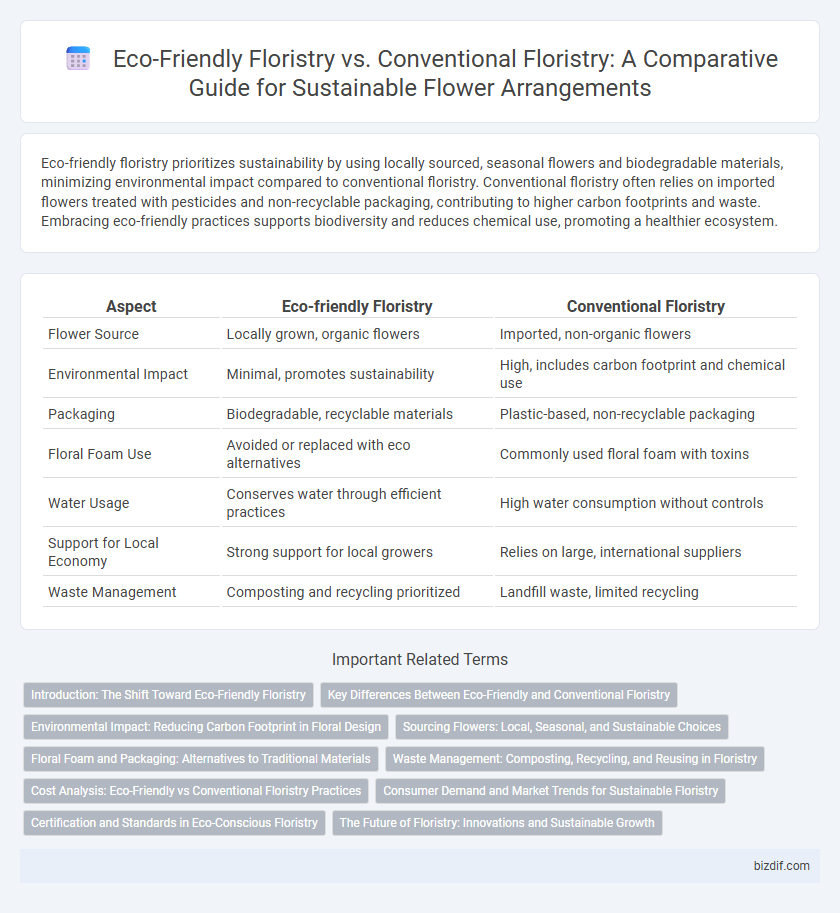Eco-friendly floristry prioritizes sustainability by using locally sourced, seasonal flowers and biodegradable materials, minimizing environmental impact compared to conventional floristry. Conventional floristry often relies on imported flowers treated with pesticides and non-recyclable packaging, contributing to higher carbon footprints and waste. Embracing eco-friendly practices supports biodiversity and reduces chemical use, promoting a healthier ecosystem.
Table of Comparison
| Aspect | Eco-friendly Floristry | Conventional Floristry |
|---|---|---|
| Flower Source | Locally grown, organic flowers | Imported, non-organic flowers |
| Environmental Impact | Minimal, promotes sustainability | High, includes carbon footprint and chemical use |
| Packaging | Biodegradable, recyclable materials | Plastic-based, non-recyclable packaging |
| Floral Foam Use | Avoided or replaced with eco alternatives | Commonly used floral foam with toxins |
| Water Usage | Conserves water through efficient practices | High water consumption without controls |
| Support for Local Economy | Strong support for local growers | Relies on large, international suppliers |
| Waste Management | Composting and recycling prioritized | Landfill waste, limited recycling |
Introduction: The Shift Toward Eco-Friendly Floristry
The floristry industry is increasingly adopting eco-friendly practices to reduce environmental impact, emphasizing sustainable sourcing, biodegradable materials, and minimal waste. Unlike conventional floristry, which often relies on chemical fertilizers, non-recyclable plastics, and long-distance flower imports, eco-friendly floristry prioritizes local blooms, organic cultivation, and compostable packaging. This shift addresses growing consumer demand for greener options and contributes to biodiversity preservation and carbon footprint reduction.
Key Differences Between Eco-Friendly and Conventional Floristry
Eco-friendly floristry prioritizes sustainable practices such as using locally sourced, seasonal flowers grown without harmful pesticides, biodegradable packaging, and minimal waste generation. In contrast, conventional floristry often relies on imported blooms treated with chemicals, non-recyclable materials, and practices that contribute to higher carbon footprints. These key differences highlight the environmental impact and sustainability focus that set eco-friendly floristry apart.
Environmental Impact: Reducing Carbon Footprint in Floral Design
Eco-friendly floristry significantly reduces carbon footprint by utilizing locally sourced, seasonal flowers and biodegradable materials, minimizing transportation emissions and waste. Conventional floristry often relies on imported flowers and non-recyclable packaging, increasing energy consumption and environmental degradation. Sustainable practices in floral design promote soil health, conserve water, and reduce chemical use, fostering a greener ecosystem.
Sourcing Flowers: Local, Seasonal, and Sustainable Choices
Eco-friendly floristry prioritizes sourcing flowers locally and seasonally to reduce carbon footprints and support sustainable agriculture, contrasting with conventional floristry's reliance on imported, out-of-season blooms that contribute to high transportation emissions and resource-intensive farming. Local farms often use organic methods, minimizing pesticide use and promoting biodiversity, whereas conventional supply chains typically involve heavy chemical inputs and long-distance shipping. Choosing sustainable floral sources ensures fresher arrangements with less environmental impact, aligning with growing consumer demand for eco-conscious products.
Floral Foam and Packaging: Alternatives to Traditional Materials
Eco-friendly floristry replaces traditional floral foam, which is non-biodegradable and toxic, with sustainable alternatives like biodegradable foam, moss, or reusable chicken wire structures to reduce environmental impact. Packaging shifts from plastic wraps and foam trays to compostable kraft paper, recyclable cardboard boxes, and plant-based cellophane, promoting circular economy principles. These material substitutions not only minimize landfill waste but also support healthier ecosystems by avoiding harmful chemical leachates associated with conventional floristry products.
Waste Management: Composting, Recycling, and Reusing in Floristry
Eco-friendly floristry significantly reduces waste by implementing composting practices for plant materials, recycling floral foam alternatives, and reusing containers and ribbons, which minimizes landfill contributions. Conventional floristry often relies on non-biodegradable floral foam and single-use plastics that enhance waste production and environmental harm. Efficient waste management in eco-friendly floristry promotes sustainability by closing resource loops and lowering the carbon footprint associated with floral arrangements.
Cost Analysis: Eco-Friendly vs Conventional Floristry Practices
Eco-friendly floristry often incurs higher upfront costs due to sustainable materials like biodegradable floral foam and organic fertilizers but reduces long-term expenses through waste minimization and energy efficiency. Conventional floristry tends to have lower initial expenses with synthetic preservatives and non-recyclable packaging but may face higher environmental compliance costs and waste disposal fees over time. Analyzing total cost of ownership reveals that eco-friendly practices can offer better economic sustainability by balancing initial investments with long-term savings and consumer demand for environmentally responsible products.
Consumer Demand and Market Trends for Sustainable Floristry
Consumer demand for eco-friendly floristry has surged as sustainability becomes a key purchasing factor, driving florists to adopt biodegradable materials and locally sourced blooms. Market trends indicate a growing preference for floral arrangements that minimize carbon footprints and support ethical farming practices. Conventional floristry faces increasing pressure to reduce waste and chemical usage to remain competitive in an evolving market focused on environmental responsibility.
Certification and Standards in Eco-Conscious Floristry
Eco-conscious floristry adheres to stringent certification programs like Rainforest Alliance and Fair Trade, ensuring sustainable sourcing and ethical labor practices. These standards promote the use of biodegradable materials and minimize chemical fertilizers and pesticides, reducing environmental impact compared to conventional floristry. Certification in eco-friendly floristry guarantees compliance with eco-label criteria, fostering biodiversity and supporting local communities through transparent supply chains.
The Future of Floristry: Innovations and Sustainable Growth
Eco-friendly floristry emphasizes biodegradable materials, locally sourced flowers, and reduced waste, driving a sustainable growth model that minimizes environmental impact. Innovations such as hydroponic flower farming and plant-based packaging enhance resource efficiency and promote ethical practices within the industry. This shift toward sustainability positions eco-friendly floristry as a scalable, responsible alternative to conventional methods reliant on chemical pesticides and extensive carbon footprints.
Eco-friendly Floristry vs Conventional Floristry Infographic

 bizdif.com
bizdif.com